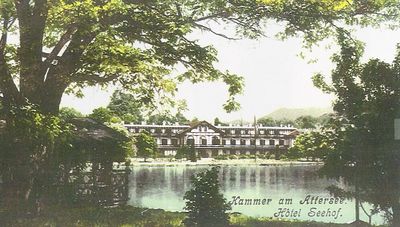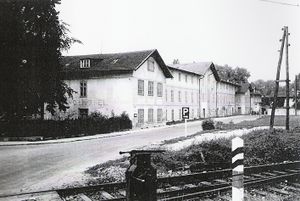Hotel Kammer (english)

The Hotel Kammer was a famous hotel in Schörfling am Attersee.
The Kammer Brewery
Franz Christoph Khevenhüller carried out a series of structural changes after the takeover of the Kammer Castle in 1581. Probably a brewery was in operation at this time, exact records are missing however. As early as 1614, a "Hofwirt" (house Kammer 6 - formerly an old pharmacy, later Schuster Rydl and Pizzeria, Hauptstraße 3) was already in the tavern Kammer. There was a tavern until the 19th century. 1687 was a Mathias Kurzer "Count Khevenhillers Preumaister". The brewery was situated south of today's pharmacy.
In 1866, the operation of the Hoftaverne ceased. The owner of the tavern Anton Köck bought the Waldmeisterhaus in Kammer 16, today Agerstraße 34, and called it "Hofwirth".
Grand-Hôtel Kammer
In 1870 August Horvath converted the brewery (Kammer No. 18) into the Hôtel Kammer. The construction period was around 2 years. In the spring of 1878, a brochure of the hotel, castle and seaside resort was published. The gardens, warming baths and the ship mooring were particularly mentioned.
With the opening of the railway line to Kammer, the hotel hoped for more guests. Expectations could not be met, the economic situation of Kammer deteriorated increasingly. In April 1903 the property of the Khevenhüller-Hórvath estate was auctioned.
Hotel Seehof
After the economic decline and the auction the hotel came to Julius Steiner from Vienna.
He invested and in 1906 the "Hotel Seehof" was mentioned for the first time. Despite great efforts, there was again a change of ownership to Sophie Gassauer, Vienna. An expansion building was added and a central heating system was installed in 1911.
Between 1916 and 1925 there were a number of further owners until 1925 the house came to Mathias Ebner, St. Gilgen. After a renovation, there was an economic upswing.
In a prospectus around 1930 the following points were pointed out: "House of first rank - all comfort: like running water, apartments with bathroom, lift, modern common rooms, confectionery and café, carboxes, ..., men's and women's hairdresser and a bank in the house."
The hotel was open from mid of may until mid of September.

In 1941, Ebner sold the hotel to the Reichsinnenministerium for 680,000 Reichsmark (RM). An official school was built in the house. From May 1, 1943 on, the building was given to the naval command, which from 1944 onwards led a "Marineschule". About 20 teachers and 160 pupils lived in the house.
On May 6, 1945, the Americans confiscated the building and set up a hospital by October. In the summer of 1946 the Americans withdrew.
As a "German property" the house felt to the republic, which set up a financial central school for the training of officials and tax collectors. The last course in the financial school took place from September to December 1951.
The last few years
From 1952 to 1953 Dr. Czernin, Vienna, rented the house and built a children's home.
From October 1956 it served as a home for the refugees after the Hungarian uprising. About 800 Hungarians found accommodation there for a few months, Caritas Linz took over the care.
From 15 April 1957 to 15 July 1958 it was Hungarian Realgymnasium. Around 350 pupils were admitted, 95 maturated in the spring of 1958.
-
Hungarian gymnasts in front of the hotel
-
Hungarian high school students in the dining room
-
Menu plan 1957
In the middle of August 1958 the building came to OÖ Landesfinanzdirektion. After being vacated for a few years, the demolition was decided on October 25, 1962, after which the hotel was demolished until February 1963.
At the same year, the "Esplanade" was opened. In front of this esplanade is now the Marina Schörfling.
Pictures
Sources
- August Mayer, The History of the House Kammer 18
- Diocesan Archives Linz






